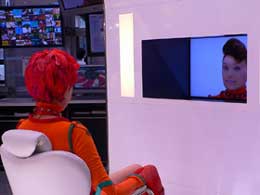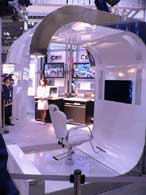Toshiba’s “Digital Kagami (mirror) F-type” uses the “Cell” next-generation microprocessor to recognize a human face in real time, and impose various virtual makeup styles and hairstyles over the image and then display it on the screen. With real time motion tracking, it looks like a virtual mirror (3.6 M video).


The “3D makeup simulation” and the “3D hairstyle simulation” detect key features of a user’s face and estimate a 3D map of the face. First, the applications capture a user’s face with a camera and detect the position of key features of the face using image recognition technology. By matching the 2D positions of the features to a computer graphic image using a 3D face model, the applications estimate what direction the user is facing and the 3D positions of the face’s 500 features.
Then, the technology adds on a makeup texture, which looks like shading on Kabuki actors, onto a 3D model and displays it on the screen. Real images such as eyeballs and the mouth viewed through the camera are displayed without modification in areas with no makeup.
3D hairstyle simulation technology employs a method called “image-based rendering.” An image is selected and composed in line with the position and direction of the user’s face using a database storing 50-100 images shot from different angles for a hairstyle on an on-demand basis.
Via tech-on.
